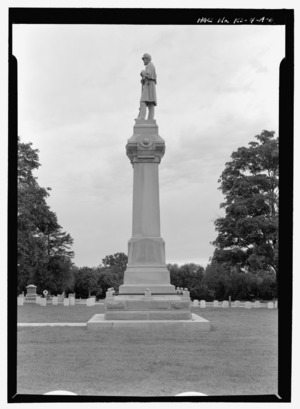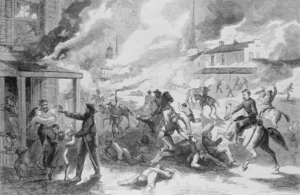Kansas in the American Civil War facts for kids
When the American Civil War began, Kansas was a very new state. Its state constitution did not allow slavery. Kansas joined the Union side in the war. However, some people in Kansas still supported slavery. These strong disagreements led to many conflicts. Famous events included the Lawrence Massacre in August 1863. Later, Union General Alfred Pleasonton defeated Confederate General Sterling Price at the Battle of Mine Creek.
Contents
Kansas Becomes a State
Kansas officially became a state in the Union in January 1861. This happened just before the Civil War started. Before statehood, there was a lot of guerrilla fighting. This fighting was between groups who wanted slavery and those who did not. This period was known as "Bleeding Kansas".
After several tries, the "Wyandotte Constitution" was approved. It was sent to the United States Congress for Kansas to become a state. Kansas joined the Union as a free state on January 29, 1861. It was the 34th state.
Even after Kansas became a state, strong disagreements continued. The border between Kansas and Missouri remained a dangerous place. Guerrilla groups from both sides caused trouble there. For example, in 1863, William Quantrill led a pro-Southern group. They attacked Lawrence, a town known for being anti-slavery. They burned much of the town and killed over 150 men and boys.
Kansas Soldiers Join the Fight
Less than three months after Kansas became a state, the Civil War began. Confederate troops attacked Fort Sumter on April 12. In Washington, D.C., there were worries about President Abraham Lincoln's safety. A senator from Kansas, James Henry Lane, helped protect the President.
Senator Lane organized 120 men from Kansas. They were called the "Frontier Guard." For three weeks, they stayed at the White House to protect President Lincoln. Most Kansans wanted to join the Union in the war. Governor Charles Robinson and Senator Lane helped recruit soldiers for the Union Army.
The federal government asked Kansas for 16,654 men. But more than 20,000 Kansans joined the army. The state sent 19 regiments and four batteries to fight. Some of these soldiers came from other states. This was because Kansas only had about 30,000 men old enough to join the military. Kansas soldiers suffered about 8,500 casualties during the war.
The Lawrence Massacre
The first major event in Kansas was not a battle between armies. It was a guerrilla raid in August 1863. Pro-slavery irregular forces led by W.C. Quantrill attacked Lawrence. Lawrence was a center for anti-slavery feelings. The raiders killed about 180 men and boys. They also destroyed many buildings.
People heard the raiders shouting “Remember Osceola!” This suggested the attack was revenge. It was likely for an earlier raid by anti-slavery jayhawkers on Osceola, Missouri. Some also thought it was a response to the deaths of some raiders' female relatives. Their jailhouse had collapsed, but research shows it was likely an accident. The Confederate government was very upset by this attack. They had supported Quantrill before, but after this, they stopped supporting irregular forces.
Later Battles in Kansas
The Battle of Baxter Springs was a smaller battle. It is sometimes called the Baxter Springs Massacre. This fight happened on October 6, 1863. It took place near the town of Baxter Springs, Kansas.
On October 25, 1864, three battles happened. The first two were in Linn County, Kansas. The last one was in Vernon County, Missouri. The first battle was the Battle of Marais des Cygnes. It was also called the "Battle of Trading Post." The second was a cavalry battle called the Battle of Mine Creek.
This was an important battle between mounted cavalry. Confederate forces under Major General Sterling Price were pursued by Union cavalry. Price was leading the Missouri expedition. Union forces were led by Major General Alfred Pleasonton. Price moved south from Kansas City. Pleasonton met him first at Marais des Cygnes. By the end of the day, the Confederate army was badly defeated. They had to retreat into Arkansas.



